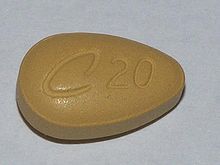Icos
Boosted by a unique advertising campaign led by the Grey Worldwide Agency, sales from Cialis allowed Icos to become profitable in 2006.
[5] The name Icos comes from icosahedron, a 20-sided polyhedron, which is the shape of many viruses,[2] and was chosen because the founders originally thought retroviruses might be involved in inflammation.
[6] The founders raised $33 million in July 1990 from many investors, including Bill Gates – who at the time was the largest shareholder, with 10% of the equity.
[7] George Rathmann, seen as a guiding father to Icos, left the company in February 2000, and was replaced as CEO and chairman by Paul Clark, a former executive at Abbott Laboratories.
[8][9] A former Icos manager named short-sighted leadership by Clark as a factor in the failure of the company to develop any other successful drugs apart from Cialis.
[3] Sold as Cialis and initially codenamed IC351,[10] tadalafil is a drug prescribed for erectile dysfunction (ED) and approved for pulmonary arterial hypertension (PAH).
[10] In addition to ED and PAH, tadalafil has undergone clinical trials for the treatment of benign prostatic hyperplasia and for female sexual dysfunction.
[13][14] The drug was originally researched as a treatment for cardiovascular diseases such as hypertension and angina,[13] but focus quickly shifted to ED with the success of another PDE5 inhibitor, sildenafil (Viagra), which had been developed by Pfizer.
[11] The release of Cialis in the United States was delayed in April 2002 when the Food and Drug Administration (FDA) recommended that Icos perform more studies, improve labelling, and address manufacturing issues.
[19][20] In the United States, Pfizer filed suit against Lilly Icos soon after receiving a broad US patent for PDE5 inhibitors in October 2002.
[27] Although many parents objected to the ad being aired during the Super Bowl, Janet Jackson's halftime "wardrobe malfunction" overshadowed Cialis.
[2] The compounds developed by Icos were tested in clinical trials in the areas of sepsis, multiple sclerosis, ischemic stroke, heart attack, pancreatitis, pulmonary arterial hypertension, chronic obstructive pulmonary disease, interstitial cystitis, psoriasis, hemorrhagic shock, sexual dysfunction, benign prostatic hyperplasia, rheumatoid arthritis, emphysema, chronic bronchitis, and acute respiratory distress syndrome.
[32] In June 1998, Icos and many medical centers asked the FDA to waive consent requirements in situations where the patient was at high risk of dying and relatives could not be reached.
[37] Pafase is the recombinant form of platelet-activating factor acetylhydrolase (PAF-AH, also known as lipoprotein-associated phospholipase A2), an enzyme made naturally by macrophages and found in human blood.
[37][39] The enzyme was discovered in the mid-1980s by graduate student Diana Stafforini and researchers Steve Prescott, Guy Zimmerman, and Tom McIntyre at the University of Utah.
[41] Early trials for sepsis showed that the drug reduced the death rate after 28 days and patients were less likely to develop severe respiratory problems.
[38] However, Icos halted development in December 2002 when interim data from phase III trials for sepsis showed that the drug did not help patients survive.
[43] In June 2000, Icos and Texas Biotechnology formed a 50/50 partnership to research endothelin receptor antagonists for use in the areas of pulmonary hypertension and chronic heart failure.
[59] After Icos's experimental drugs failed in clinical trials, Eli Lilly was in a prime position to purchase the company.
[4][65] In December 2007, CMC Biopharmaceuticals A/S, a Copenhagen-based provider of contract biomanufacturing services, bought the Bothell biologics facility and retained the existing 127 employees.
[67][68] Senior executives at Icos received cash payments worth a combined $67.8 million for selling the company to Eli Lilly.


